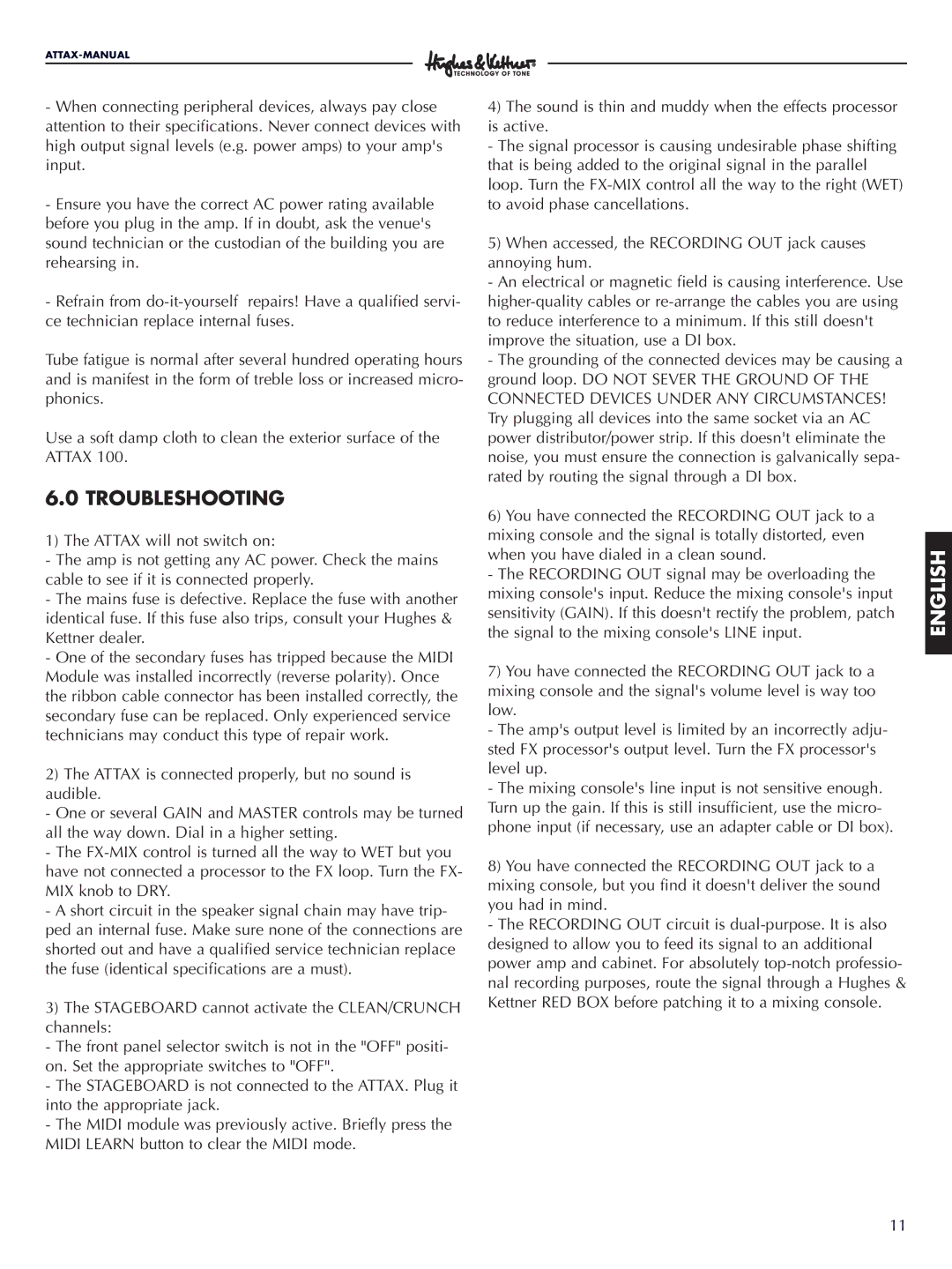
-When connecting peripheral devices, always pay close attention to their specifications. Never connect devices with high output signal levels (e.g. power amps) to your amp's input.
-Ensure you have the correct AC power rating available before you plug in the amp. If in doubt, ask the venue's sound technician or the custodian of the building you are rehearsing in.
-Refrain from
Tube fatigue is normal after several hundred operating hours and is manifest in the form of treble loss or increased micro- phonics.
Use a soft damp cloth to clean the exterior surface of the ATTAX 100.
6.0 TROUBLESHOOTING
1) The ATTAX will not switch on:
-The amp is not getting any AC power. Check the mains cable to see if it is connected properly.
-The mains fuse is defective. Replace the fuse with another identical fuse. If this fuse also trips, consult your Hughes & Kettner dealer.
-One of the secondary fuses has tripped because the MIDI Module was installed incorrectly (reverse polarity). Once the ribbon cable connector has been installed correctly, the secondary fuse can be replaced. Only experienced service technicians may conduct this type of repair work.
2)The ATTAX is connected properly, but no sound is audible.
- One or several GAIN and MASTER controls may be turned all the way down. Dial in a higher setting.
- The
- A short circuit in the speaker signal chain may have trip- ped an internal fuse. Make sure none of the connections are shorted out and have a qualified service technician replace the fuse (identical specifications are a must).
3)The STAGEBOARD cannot activate the CLEAN/CRUNCH channels:
- The front panel selector switch is not in the "OFF" positi- on. Set the appropriate switches to "OFF".
- The STAGEBOARD is not connected to the ATTAX. Plug it into the appropriate jack.
- The MIDI module was previously active. Briefly press the MIDI LEARN button to clear the MIDI mode.
4)The sound is thin and muddy when the effects processor is active.
- The signal processor is causing undesirable phase shifting that is being added to the original signal in the parallel loop. Turn the
5)When accessed, the RECORDING OUT jack causes annoying hum.
- An electrical or magnetic field is causing interference. Use
- The grounding of the connected devices may be causing a ground loop. DO NOT SEVER THE GROUND OF THE CONNECTED DEVICES UNDER ANY CIRCUMSTANCES! Try plugging all devices into the same socket via an AC power distributor/power strip. If this doesn't eliminate the noise, you must ensure the connection is galvanically sepa- rated by routing the signal through a DI box.
6)You have connected the RECORDING OUT jack to a mixing console and the signal is totally distorted, even when you have dialed in a clean sound.
- The RECORDING OUT signal may be overloading the mixing console's input. Reduce the mixing console's input sensitivity (GAIN). If this doesn't rectify the problem, patch the signal to the mixing console's LINE input.
7)You have connected the RECORDING OUT jack to a mixing console and the signal's volume level is way too low.
- The amp's output level is limited by an incorrectly adju- sted FX processor's output level. Turn the FX processor's level up.
- The mixing console's line input is not sensitive enough. Turn up the gain. If this is still insufficient, use the micro- phone input (if necessary, use an adapter cable or DI box).
8)You have connected the RECORDING OUT jack to a mixing console, but you find it doesn't deliver the sound you had in mind.
- The RECORDING OUT circuit is
ENGLISH
11
